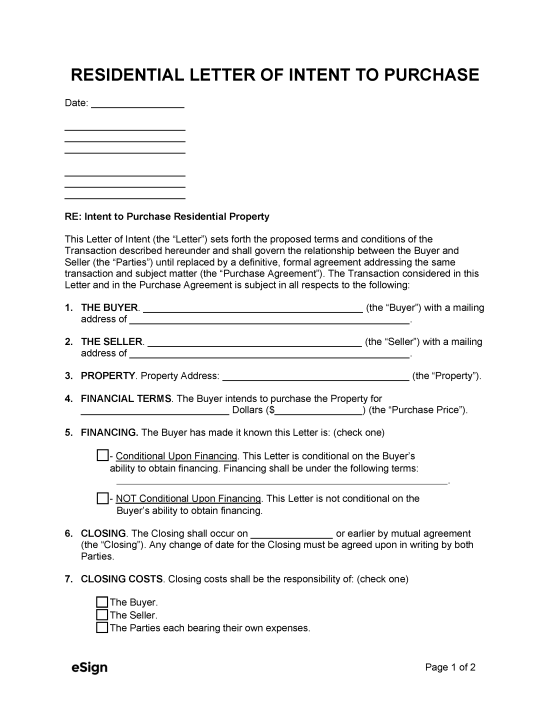

A residential letter of intent (LOI) to purchase is used by interested home buyers to begin the negotiation process with a property seller. The letter relays the buyer’s intention and financial offer to purchase the seller’s property. If the seller signs the letter, they agree to work towards a definitive purchase contract with the buyer.
An LOI to purchase residential property will look a lot like a purchase contract. However, its terms are generally non-binding and simplified. The letter will often contain the information listed below.
[SENDER (i.e., BUYER) NAME]
[SENDER STREET ADDRESS]
[SENDER CITY, STATE, ZIP]
[RECIPIENT (i.e., SELLER) NAME]
[RECIPIENT STREET ADDRESS]
[RECIPIENT CITY, STATE, ZIP]
RE: Intent to Purchase Property
This Letter of Intent (the “Letter”) sets forth the proposed terms and conditions of the transaction described hereunder and shall govern the relationship between the Buyer and Seller (the “Parties”) until replaced by a definitive, formal agreement addressing the same transaction and subject matter (the “Definitive Agreement”). The transaction considered in this Letter and in the Definitive Agreement is subject in all respects to the following:
Please note: Any sections that do not apply may be struck through or deleted.
1. THE BUYER. [BUYER NAME] (the “Buyer”) with a mailing address of [BUYER MAILING ADDRESS] .
2. THE SELLER. [SELLER NAME] (the “Seller”) with a mailing address of [SELLER MAILING ADDRESS] .
3. TRANSACTION This Letter is for the purchase of the Property located at [PROPERTY ADDRESS] (the “Property”) for $[AMOUNT] (the “Purchase Price”).
4. FINANCING. This Letter i s: ☐ – Conditional Upon Financing ☐ – Not Conditional Upon Financing.
5. CLOSING. The Closing shall occur on [DATE] (the “Closing”). Any change of date for the Closing must be agreed upon in writing by both Parties.
6. CLOSING COSTS. All costs associated with the Closing shall be the responsibility of (check one) ☐ the Buyer ☐ the Seller ☐ the Parties each bearing their own expenses.
7. POSSESSION. Possession of the Property shall be given on [DATE] (the “Possession”). Any change of date for the Possession must be agreed upon in writing by the Buyer and Seller.
8. STANDSTILL AGREEMENT. Following the execution of this Letter, and until Closing, the Seller shall not negotiate for the sale of the Property with any other party unless either the Parties agree in writing to terminate this Letter, or the Parties fail to sign a Purchase Agreement by [DATE] .
9. INTENTION OF THE PARTIES. This Letter sets forth the intentions of the Parties to use reasonable efforts to negotiate, in good faith, a Definitive Agreement with respect to all matters herein. Notwithstanding paragraphs 4 and 8 through 11, which shall be legally binding, any legal obligations with respect to all other matters shall only arise if and when the Parties execute and deliver a Definitive Agreement.
10. GOVERNING LAW. This Letter shall be governed under the laws of the State of [STATE NAME] .
11. SIGNATURES.
Seller Signature: ____________________________
Date: [MM/DD/YYYY] Print Name: [SELLER PRINTED NAME]
Buyer Signature: ____________________________
Date: [MM/DD/YYYY] Print Name: [BUYER PRINTED NAME]
The buyer will usually visit the property and discuss terms with the seller before they draft their letter of intent. An LOI that has been signed by both parties represents their intention to reach a definitive agreement. The LOI allows the buyer and seller to negotiate through a non-binding agreement that can be terminated at any time. Also, if it’s a standstill agreement, the buyer can negotiate and make a purchase contract without the risk of being undercut by another buyer.